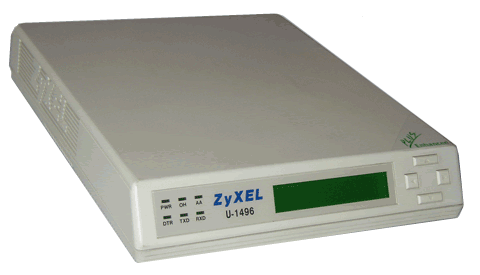

The UNAVCO Boulder Facility has used the ZyXEL U-1496P Portable Cellular Modem, available from ZyXEL (http://www.zyxel.com), in remote communication applications. The cellular modem is used with a Motorola Cellular Phone and a 10dB directional Yagi antenna. The U-1496P is capable of transmission speeds up to 19.2 kbps full-duplex on a 2-wire dial-up line. Universal compatibility covers a broad range of CCITT and Bell standards and provides data compression, asynchronous and synchronous operations, MNP and V.42 error correction and data compression.
Below are the suggested settings of the Zyxel Cellular Phone Modem when directly attached to a Trimble 4000 SSE/SSI receiver and using the Trimble "rfile -f" program. The modem is set at 9600 baud and Zyxel Cell 9600 transfer protocol.
Zyxel settings (when attached to mobile phone): B0 E1 L2 M1 N5 Q0 V1 X5
&B1 &C1 &D0 &G0 &H3 &J0 &K4 &L0 &M0 &N44 &P0 &R1 &S0 &X0 &Y1 *B0 *C0 *D0 *E0 *F0 *G0 *I0 *L0 *M0 *P9 *Q2 *S0 S00=001 S01=000 S02=043 S03=013 S04=010 S05=008 S06=003 S07=060 S08=002 S09=006 S10=007 S11=070 S12=000 S13=000 S14=003 S15=002 S16=000 S17=018 S18=000 S19=044 S20=007 S21=050 S22=040 S23=105 S24=074 S25=000 S26=000 S27=156 S28=068 S29=000 S30=000 S31=017 S32=019 S33=255 S34=030 S35=032 S36=000 S37=000 S38=000 S39=000 S40=000 S41=000 S42=064 S43=000 S44=000 S45=100 S46=028 S47=064 S48=000 S49=137 S50=002 S51=000 S52=000 S53=000 S54=000 s55=000 S56=000 S57=000 S58=000 S59=000 Receiver set up: BAUD RATE / FORMAT = 9600, 8, NONE, 1, no flow control REMOTE PROTOCOL = DATA COLLECTOR COMPATIBLE Attach the receiver to the remote modem via a null modem cable. Zyxel settings (when installed in office): S49=000
If you are interested in more information about how the ZyXEL Cellular Modem is being used by the UNAVCO Boulder Facility in the field select the link below:
Important notes: Optimizing the cellular connection to an acceptable level of data throughput can sometimes be difficult. Local cellular providers may perform operations that are undetectable for voice communication but are incompatible with high speed data transfers. The data communication should be tested by doing a receiver download from a remote site. At certain locations we found the V.32 (4800 bps) protocol (&N5) to work flawlessly while the recommended CELL4800 protocol (&N46) did not work at all or was at best intermittent. Switching the local cellular provider may also improve the cellular reception and thus the data throughput. As with the phone modem, echo should be turned off (E0) at the remote modem to avoid sending data back to the receiver that may cause it to freeze up. DTE/DCE rate is fixed at the DTE setting (see S18, S20, S44b6) to avoid connection at other DTE speeds than what is set in the receiver. We currently use RTS/CTS hardware flow control with our remote communications but no error control or data compression.
Troubleshooting tips:
Make sure that the local cellular provider at the remote site is not performing any activities or operations such as multiplexing or data compression that will impact the connectivity and data throughput.
To maximize reception the directional antenna must be turned until maximum reception is indicated on the cellular phone handset. Consult the manufacturer manual for details. Note that the direction of the best reception may change if you switch local cellular providers. Also, the directional Yagi antenna has a considerable front- and backlobe which can affect the GPS signal reception if the Yagi antenna is pointed towards (0 deg) or away from (180 deg) the GPS antenna.
Longer waiting time for carrier (S7) and longer duration after loss of carrier (S10) before hanging up may increase the chances for a successful connection.
The cellular (remote) modem transmit power can be adjusted for maximum reception. But an increased power level can saturate the modem and make it more difficult to make a connection.
If repeated calls are being made, allow the modem to disconnect the previous call and reset itself before another attempt is made; or, a separate command should be sent to the local modem to bring the DTR line low if the originating software program does not perform this automatically. This is important when using an automated script to download the receivers. Consult the ZyXEL U-1496 Series User’s Manual for details.
Article ID: 358
Created: September 21, 2009
Last Updated: September 21, 2009
Author: Beth Bartel
Online URL: https://kb.unavco.org/article/zyxel-u-1496p-portable-cellular-modem-summary-358.html